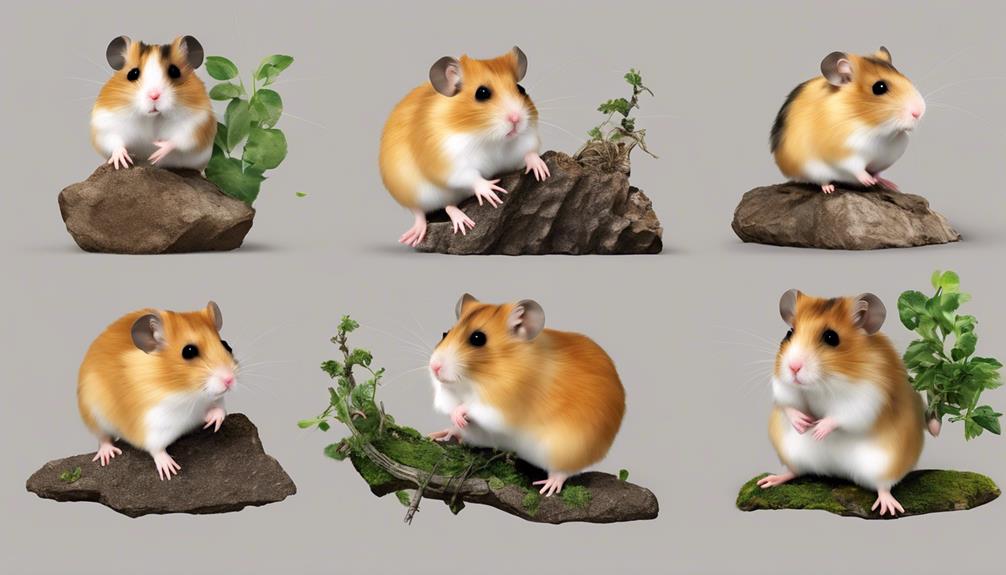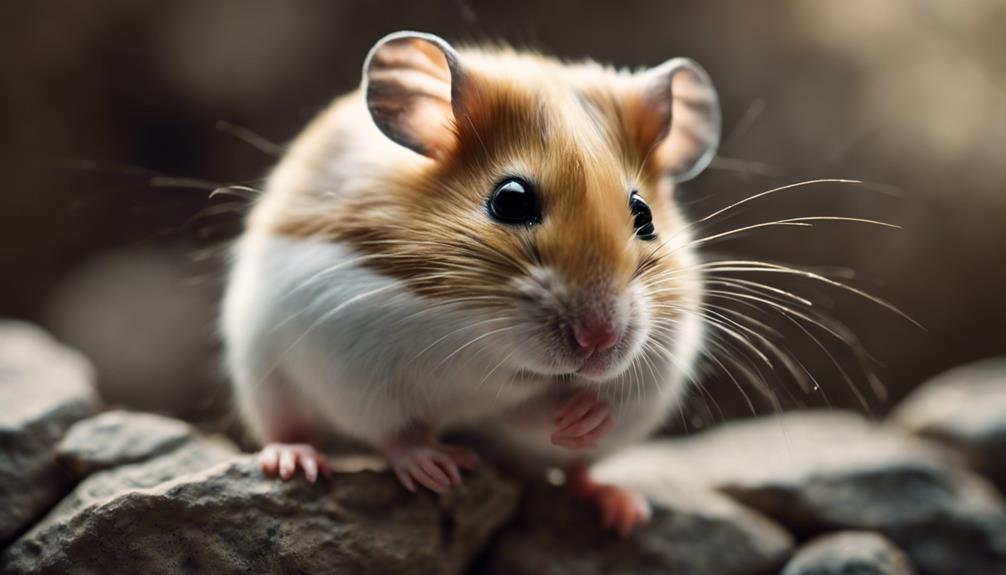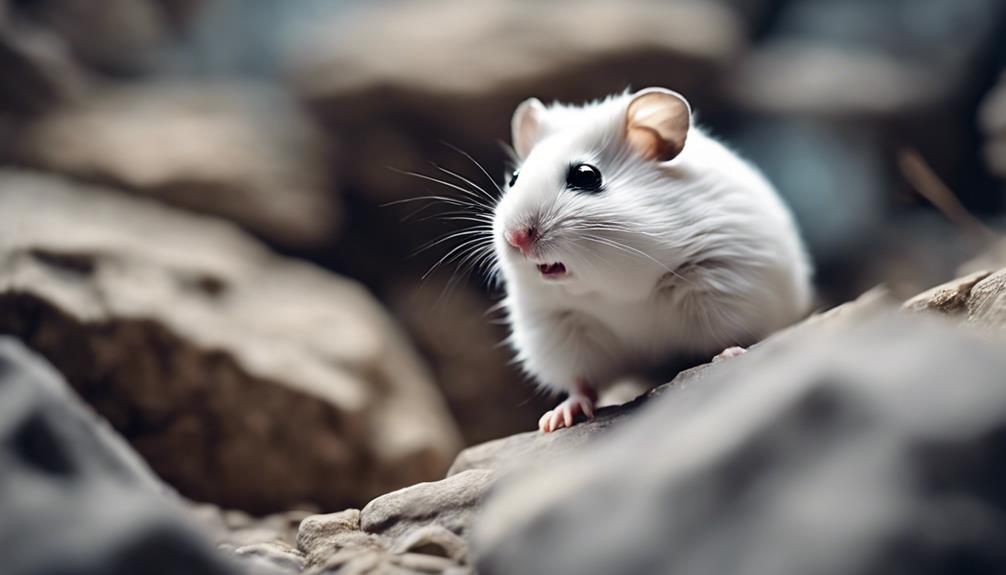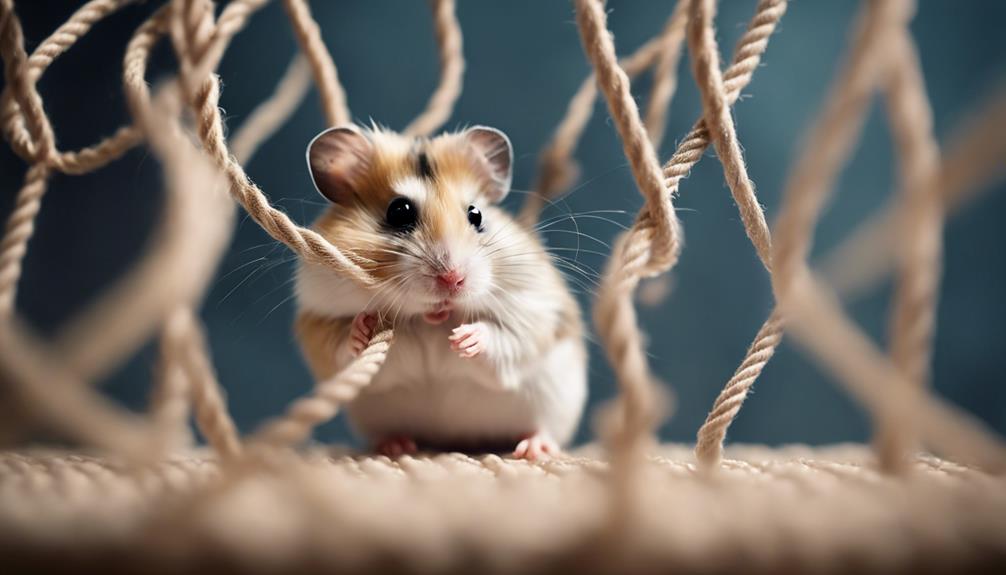What Are the Climbing Abilities of Various Hamster Species?

The Climbing Abilities of Various Hamster Species:
Discover the unique adaptations that enable hamsters to navigate vertical terrains with agility and skill, shedding light on their behavior and anatomy.
Roborovski Hamsters: Agile Climbers
Roborovski hamsters consistently showcase their remarkable agility as climbers, effortlessly navigating through intricate obstacles with swift precision. Renowned for their vertical exploration, these hamsters exhibit a natural inclination towards scaling various surfaces with finesse and ease. Their climbing behavior is a testament to their innate abilities and inherent adaptability to diverse environments.
When observing Roborovski hamsters engaging in their climbing activities, one can't help but marvel at the grace and dexterity with which they ascend and descend structures. Their nimbleness allows them to conquer heights that might seem daunting to other hamster species. This agility not only serves as a means of physical exercise but also fulfills their instinctual urge for exploration and freedom.
In essence, the climbing prowess of Roborovski hamsters is a sight to behold, embodying the spirit of freedom and resilience. Their adeptness at navigating vertical terrains showcases the beauty of nature's design and the boundless capabilities of these tiny creatures.
Syrian Hamsters: Adept at Climbing
With a keen eye for vertical challenges, do Syrian hamsters exhibit a natural prowess for climbing that rivals their counterparts in the animal kingdom? Syrian hamsters, also known as golden hamsters, display remarkable climbing abilities that showcase their agility and curiosity.
Here are four key insights into the climbing behavior and environmental factors influencing Syrian hamsters' vertical exploration:
- Natural Climbers: Syrian hamsters possess an innate ability to climb various surfaces, utilizing their sharp claws and flexible bodies to ascend with ease.
- Environmental Enrichment: Providing ample opportunities for climbing structures and platforms in their habitat can enhance a Syrian hamster's well-being and mental stimulation.
- Curiosity and Exploration: These hamsters are curious creatures by nature, and their climbing activities often stem from a desire to explore their surroundings vertically.
- Physical Adaptations: Their strong hind legs and agile bodies equip Syrian hamsters for successful vertical navigation, making them adept climbers in the realm of small mammals.
Chinese Hamsters: Climbing Skills

The climbing skills of Chinese hamsters demonstrate a remarkable blend of agility and precision, showcasing their innate ability to navigate vertical terrains with finesse. These hamsters face various climbing challenges in their natural habitats, such as navigating through rocky terrains and scaling tree branches to escape predators or search for food. To overcome these obstacles, Chinese hamsters have developed impressive behavioral adaptations that aid in their climbing abilities.
Their keen sense of balance, coupled with strong limbs and sharp claws, allows them to grip onto surfaces securely while making swift ascents. Observing these creatures in their element reveals a harmonious relationship between their physical attributes and instinctual behaviors, highlighting the efficiency of their climbing skills. Chinese hamsters' agility and adaptability enable them to conquer vertical obstacles with ease, embodying a spirit of freedom and resilience in their natural environment.
Campbell's Dwarf Hamsters: Climbing Abilities
Exhibiting remarkable agility and tenacity, Campbell's Dwarf Hamsters showcase impressive climbing abilities that reflect their innate prowess in navigating vertical environments. These tiny creatures have specific preferences when it comes to climbing and benefit greatly from the exercise it provides. To cater to their natural inclinations, hamster owners can enhance their pets' environment using suitable cage accessories and engaging enrichment activities.
Here are some essential considerations for supporting Campbell's Dwarf Hamsters' climbing abilities:
- Climbing Preferences: Campbell's Dwarf Hamsters are inclined to climb due to their natural instincts, making vertical spaces an essential aspect of their habitat design.
- Exercise Benefits: Climbing offers these hamsters physical exercise, mental stimulation, and the opportunity to exhibit their natural behaviors in captivity.
- Cage Accessories: Providing appropriately sized platforms, ladders, and tubes can encourage and facilitate climbing within the hamster's enclosure.
- Enrichment Activities: Incorporating climbing challenges such as ropes or textured surfaces can add variety to the hamster's environment and promote physical activity and mental engagement.

In their natural habitat, Winter White Hamsters demonstrate remarkable prowess in navigating vertical spaces, showcasing agility and adaptability in their movements. These hamsters, also known as Siberian Hamsters, have evolved to thrive in the cold climates of their native regions, which include parts of Siberia and Mongolia. Their vertical navigation skills allow them to climb, explore, and escape predators effectively.
| Aspect | Description | Importance |
|---|---|---|
| Winter white hamsters: burrowing behavior | Winter White Hamsters are skilled burrowers, creating intricate tunnel systems underground for nesting, storing food, and seeking refuge from extreme temperatures. | Facilitates survival in harsh environments |
| Winter white hamsters: social interactions | While Winter White Hamsters can be territorial, they also engage in social interactions with their kin, forming close-knit family groups that collaborate for survival. | Enhances emotional well-being and cooperative behaviors |
| Vertical agility | Their ability to navigate vertical spaces with ease enables them to access food sources, escape predators, and create secure nests high above the ground. | Essential for survival and environmental adaptation |
Robust Climbers: Hamster Species
Winter White Hamsters' exceptional vertical navigation abilities are mirrored in various hamster species, showcasing them as robust climbers in their respective environments. These hamsters exhibit remarkable skills when faced with climbing challenges and excel in vertical exploration within their habitats.
Here are four key aspects that highlight the robust climbing abilities of hamster species:
- Adaptability: Hamsters have evolved to conquer diverse terrains, from rocky outcrops to tree branches, displaying a remarkable ability to adapt to various climbing challenges.
- Strength and Agility: Their muscular build and agile movements enable hamsters to navigate vertical spaces with ease, showcasing their strength and agility in challenging environments.
- Natural Instincts: Hamsters possess innate climbing instincts that drive them to explore and conquer heights, underscoring their natural prowess as climbers.
- Environmental Mastery: These resilient creatures have mastered the art of vertical exploration, effortlessly maneuvering through intricate landscapes and utilizing their surroundings to overcome climbing obstacles.
Climbing Techniques of Hamsters

Hamsters exhibit a variety of climbing techniques that showcase their remarkable agility and adaptability. Understanding the nuances of hamster climbing behavior offers valuable insights into their natural abilities and instincts.
Observing hamster climbing abilities provides a fascinating glimpse into these small creatures' impressive skills in navigating vertical terrains.
Hamster Climbing Behavior
With nimble agility and precision, hamsters showcase a variety of climbing techniques that demonstrate their remarkable adaptability in navigating their environments.
- Utilization of Paws: Hamsters exhibit a keen usage of their paws to grip onto various surfaces securely.
- Tail Balancing: Some species may employ their tails for balance while climbing vertically or on narrow pathways.
- Vertical Ascents: Hamsters are adept at scaling vertical surfaces using a combination of jumps and quick paw movements.
- Exploratory Climbing: These creatures often engage in exploratory climbing, driven by their natural curiosity to investigate new territories and objects.
In their quest for exploration and freedom, hamsters' climbing behaviors offer a glimpse into their agile and inquisitive nature within their habitats.
Hamster Climbing Abilities
In mastering the art of climbing, hamsters display a remarkable blend of agility and adaptability, showcasing a diverse range of techniques to navigate their environments with precision. Hamsters face various climbing challenges in the wild and are known for their ability to conquer indoor obstacles in captivity. Below is a table summarizing some of the key climbing techniques employed by these small but mighty creatures:
| Climbing Technique | Description |
|---|---|
| Vertical Ascent | Utilizing sharp claws to grip and pull upward |
| Ledge Navigation | Hopping between ledges with swift movements |
| Wall Scaling | Using a combination of jumps and grips |
| Tunnel Climbing | Maneuvering through narrow spaces adeptly |
| Balance Beam Crossing | Demonstrating exceptional balance skills |
Factors Influencing Hamster Climbing
The climbing abilities of hamsters are influenced by several key factors.
Hamster size and agility play a crucial role in determining their climbing prowess.
Additionally, the effects of habitat enrichment and their natural climbing instincts also significantly impact their ability to navigate vertical terrains.
Hamster Size and Agility
Size and agility play pivotal roles in determining the climbing abilities of different hamster species. When considering these factors, several key points come to light:
- Size Comparison: Larger hamster species may struggle with agility but have the strength for more challenging climbs.
- Agility Levels: Smaller hamster breeds are often more agile, enabling them to navigate complex climbing structures with ease.
- Training Methods: Consistent training can improve a hamster's climbing skills regardless of its size or agility level.
- Climbing Techniques: Understanding each hamster species' natural climbing behaviors can aid in enhancing their climbing abilities through tailored techniques.
Habitat Enrichment Effects
Considering the pivotal role of habitat enrichment in shaping hamsters' climbing abilities, it becomes evident that various factors influence their proficiency in navigating vertical spaces. Climbing enrichment plays a crucial role in behavior modification among hamsters, encouraging them to engage in vertical exploration within their habitats.
By providing opportunities for climbing, such as ladders, branches, or platforms, owners can positively impact their hamsters' natural instincts and physical capabilities. These environmental changes not only enhance the hamsters' quality of life but also have a significant impact on their overall well-being.
Understanding the importance of habitat enrichment effects on hamsters is essential for creating a stimulating and enriching environment that supports their natural behaviors and abilities.
Natural Climbing Instincts
In the realm of hamster behavior, inherent instincts deeply influence their climbing abilities, shaping their interactions with vertical environments.
Key Points:
- Climbing behavior: Hamsters exhibit a wide range of climbing behaviors influenced by their genetic predisposition.
- Genetic Predisposition: Different hamster species have varying genetic tendencies towards climbing, affecting their proficiency in navigating vertical spaces.
- Climbing challenges: Environmental factors such as the presence of obstacles or the texture of surfaces can pose challenges for hamsters when climbing.
- Environmental factors: The surroundings play a crucial role in eliciting and enhancing hamsters' natural climbing instincts, impacting their overall climbing abilities.
Understanding these natural climbing instincts is crucial for providing suitable environments that cater to hamsters' innate behaviors and needs.
Frequently Asked Questions
Can Hamsters Climb Walls or Ceilings?
Hamsters have impressive climbing abilities, scaling walls and ceilings with ease. By incorporating cage accessories like climbing toys and employing training methods, their natural behavioral patterns can be enhanced, providing them with freedom and enrichment.
Do Hamsters Have Any Specific Adaptations That Help Them Climb?
In the realm of climbing techniques and adaptations for scaling heights, hamsters possess remarkable abilities. Their agile bodies, sharp claws, and keen sense of balance enable them to conquer vertical challenges with ease.
Are There Any Safety Concerns or Risks Associated With Hamster Climbing?
When it comes to hamsters' climbing behavior, safety precautions are essential. Providing secure climbing structures and ensuring there are no hazards like sharp edges or high falls can help prevent accidents and injuries.
How High Can Hamsters Typically Climb?
When it comes to climbing, hamsters exhibit surprising agility, but their small stature sets limitations. Safety precautions, like providing secure climbing structures and monitoring behavior, are crucial to prevent accidents and ensure the well-being of these tiny adventurers.
Do Different Hamster Species Have Different Preferences When It Comes to Climbing Structures or Surfaces?
Different hamster species exhibit unique climbing preferences when provided with habitat enrichment. Behavior observation highlights the significance of environmental enrichment in catering to their diverse needs. Understanding these nuances enhances their well-being.









